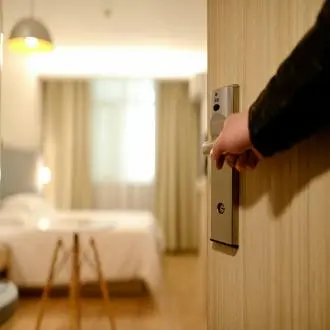Transcription workplanningandintegrationintotheteam(I)
A successful housekeeping operation is not the result of improvisation, but of meticulous planning and perfect integration of all team members.
The housekeeper orchestrates this planning, but its ultimate effectiveness depends on each person understanding their role, their tasks, and how their work connects with that of others for the smooth running of the department.
The Housekeeper's Strategic Planning
The person in charge of organizing and planning all the work of the department is the housekeeper, who assigns tasks to each of the employees under her responsibility.
One of her key tools is the work schedule, which specifies the staff's shifts and weekly schedules.
When creating this schedule, you must take into account factors such as statutory breaks, vacations, days off, and possible sick leave, while maintaining the flexibility to modify it as needed.
This schedule should be posted on a notice board so that it is visible to everyone. staff.
Every day, before starting the shift, the housekeeper analyzes the tasks to be performed, establishing the number of rooms and common areas that each employee must clean.
In addition, she communicates relevant information, such as the celebration of special events that require the preparation of rooms or the arrival of VIP clients who need special attention.
Shift Structure and Task Prioritization
Work shifts are usually organized to cover the entire hotel's operations, the most common being morning (for example, from 8:00 a.m. to 4:00 p.m.), afternoon (from 4:00 p.m. to midnight), and night (from midnight to 8:00 a.m.).
To ensure maximum efficiency, especially during the morning shift, which is the busiest, a logical order is followed when cleaning the rooms.
First, the free rooms (clean vacancies) are reviewed to ensure which are kept in perfect condition for possible immediate assignment.
Next, priority is given to the departure rooms, with the aim of making them available as soon as possible for new guests who are about to arrive.
Finally, the rooms occupied by continuing guests are attended to.
In the latter case, it is absolutely imperative to respect the "Do not disturb" sign that the guest may have posted on the door, postponing the cleaning of that room.
Time Management and Team Composition
Time management is a critical factor. It is estimated that the time required to completely clean a room ranges from 20 to 40 minutes, depending on factors such as its size or the disorder of the guest.
Evaluating these working times is essential, as it allows the housekeeper to calculate how many rooms a maid can realistically clean during her shift.
This calculation is the basis for determining staffing needs based on the hotel's occupancy at any given time, thus optimizing human resources.
The success of all this planning depends on a well-structured and cohesive team. Although they perform different tasks, all positions are interrelated.
The team consists of the Housekeeper (organizer), the Assistant Housekeeper (supervisor of the chambermaids), the Assistant Laundry Housekeeper (supervisor of that area), the Chambermaid (in charge of rooms), the Housekeeping Assistant (in charge of common areas), the Laundress and Ironer (responsible for handling linen), and the Seamstress, who handles textile repairs for both the hotel and its guests.
Summary
The Housekeeper organizes all the work of the department, assigning tasks and creating weekly schedules for the staff. On a daily basis, she communicates key information, such as the arrival of VIP guests or special events.
The work is organized into shifts to cover the operations of the hotel. Room cleaning follows a logical order of priority: first vacant rooms, then checkout rooms, and finally occupied rooms.
Time management is critical, allowing 20 to 40 minutes per room to calculate the staff required. Success depends on a well-structured team with interrelated roles.
work planning and team integration




